The Effect of Single Sandstone Stacking Pattern on the Sandstone Reservoir Physical Properties—A Case Study from the Shanxi Formation in the Daniudi Area, Northeastern Ordos Basin
Abstract
:1. Introduction
2. Geological Setting
3. Materials and Methods
4. Results
4.1. Petrographic Characteristic
4.2. Diagenetic Alteration
4.3. Single Sandbody Stacking Pattern
5. Discussion
5.1. The Relatively High-Porosity Lithofacies in Three Sandbody Stacking Patterns
5.2. The Difference of Components in Sandstones in Three Sandbody Stacking Patterns
5.3. Differences in the Degree of Diagenesis in Three Sandbody Stacking Patterns
6. Conclusions
- (1)
- The lithofacies with relatively high porosity and permeability in the Shanxi Formation are the graded bedding conglomeratic sandstone, massive gravel-bearing coarse sandstone, plate cross-bedding coarse sandstone, and massive coarse sandstone. The average porosity of the four lithofacies is greater than 8%, and their average permeability is greater than 1 × 10−3 μm2.
- (2)
- According to the change of sedimentary structure and lithology vertically, the single sandbody stacking pattern can be divided into three types, including mixed stacking patterns of coarse- to medium-grained sandstone (MSP), fining-upwards stacking patterns of coarse- to medium-grained sandstone (FSP), and coarsening-upwards stacking patterns of fine- to coarse-grained sandstone (CSP). MSP and FSP are two types of single sandbody stacking patterns with relatively good physical properties.
- (3)
- The original components lead to the different physical properties of sandstones from different single sandbody stacking patterns. There is a relatively high content of quartz, low content of sedimentary lithic fragments, and low content of matrix in sandstones from the MSP and FSP compared to the CSP, resulting in the preservation of primary pores during compaction and the formation of dissolved pores. This study has illustrated that the physical property differences of sandstones in different single sandbody stacking patterns are not clear and can improve the accuracy of high-quality sandstone reservoir predictions.
Author Contributions
Funding
Institutional Review Board Statement
Informed Consent Statement
Data Availability Statement
Acknowledgments
Conflicts of Interest
References
- Leila, M.; El Sharawy, M.; Bakr, A.; Mohamed, A.K. Controls of facies distribution on reservoir quality in the Messinian incised-valley fill Abu Madi Formation in Salma delta gas field, northeastern onshore Nile Delta, Egypt. J. Nat. Gas Sci. Eng. 2022, 97, 104360. [Google Scholar] [CrossRef]
- Gould, K.M.; Piper DJ, W.; Pe-Piper, G. Lateral variation in sandstone lithofacies from conventional core, Scotian Basin: Implications for reservoir quality and connectivity. Can. J. Earth Sci. 2012, 49, 1478–1503. [Google Scholar] [CrossRef]
- Stroker, T.M.; Harris, N.B.; Elliott, W.C.; Wampler, J.M. Diagenesis of a tight gas sand reservoir: Upper Cretaceous Mesaverde Group, Piceance Basin, Colorado. Mar. Pet. Geol. 2013, 40, 48–68. [Google Scholar] [CrossRef]
- Burki, M.; Darwish, M. Electrofacies vs. lithofacies sandstone reservoir characterization companion sequence, Arshad gas/oil field, Central Sirt Basin, Libya. J. Afr. Earth Sci. 2017, 130, 319–336. [Google Scholar] [CrossRef]
- Taylor, T.R.; Giles, M.R.; Hathon, L.A.; Diggs, T.N.; Braunsdorf, N.R.; Birbiglia, G.V.; Kittridge, M.G.; Macaulay, C.I.; Espejo, I.S. Sandstone diagenesis and reservoir quality prediction: Models, myths, and reality. AAPG Bull. 2010, 94, 1093–1132. [Google Scholar] [CrossRef]
- Du, W. Study on the Stratigraphic Sequence Stratigraphy, Sedimentary Phase and Reservoir of Shanxi Formation in Daniudi Gas Field, Ordos Basin. Ph.D. Thesis, China University of Geosciences, Beijing, China, 2013. [Google Scholar]
- Kathleen, G.; Georgia, P.; David, J.W.P. Relationship of diagenetic chlorite rims to depositional facies in Lower Cretaceous reservoir sandstones of the Scotian basin. Sedimentology 2010, 57, 587–610. [Google Scholar]
- Straub, K.M.; Mohrig, D.; Buttles, J.; McElroy, B.; Pirmez, C. Quantifying the influence of channel sinuosity on the depositional mechanics of channelized turbidity currents: A laboratory study. Mar. Pet. Geol. 2011, 28, 744–760. [Google Scholar] [CrossRef]
- Saïag, J.; Brigaud, B.; Portier, É.; Desaubliaux, G.; Bucherie, A.; Miska, S.; Pagel, M. Sedimentological control on the diagenesis and reservoir quality of tidal sandstones of the Upper Cape Hay Formation (Permian, Bonaparte Basin, Australia). Mar. Pet. Geol. 2016, 77, 597–624. [Google Scholar] [CrossRef]
- Zhang, Y. Research on the Prediction Technology of High-Quality Reservoirs in Low-Porosity Sandstone in Tabamiao Area of Ordos Basin. Ph.D. Thesis, China University of Geosciences, Beijing, China, 2008. [Google Scholar]
- Yin, S.; Chen, G.; Zhang, L.; Luo, Y.; Wang, C. The control of petrographic configuration on dense sandstone quality reservoirs: An example from the Shu II section of the Sichuan West Depression. Nat. Gas Geosci. 2016, 27, 1179–1189. [Google Scholar]
- Lin, J.; Zhang, X.; Lin, C.; Duan, D.; Huang, X.; Sun, X.; Dong, C. Reservoir evolution characteristics of deep dense sandstone gas reservoirs under petrographic constraints. Pet. Nat. Gas Geol. 2019, 40, 886–899. [Google Scholar]
- Song, J.G.; Gao, W.L. Introduction to the Chinese Petroleum Geology Journal. J. Pet. 1991, 2, 141. [Google Scholar]
- Zhang, X.; Fu, M.; Deng, H.; Li, Z.; Zhao, S.; Gluyas, J.G.; Ye, T. The differential diagenesis controls on the physical properties of lithofacies in sandstone reservoirs from the Jurassic Shaximiao Formation, westernSichuan depression, China. J. Pet. Sci. Eng. 2020, 193, 107413. [Google Scholar] [CrossRef]
- Zhang, R. Evaluation and Capacity Prediction of Low-Porosity Reservoirs in Da Niu Di Area. Master’s Thesis, Chengdu University of Technology, Chengdu, China, 2016. [Google Scholar]
- Wei, X.P.; Hu, X.; Li, H.; Zhao, J.; Zhao, L.S. Evaluation of horizontal well logging in tight sandstone gas reservoirs—Example of well area X in Daniudi gas field in Ordos Basin. Pet. Nat. Gas Geol. 2019, 40, 1084–1094. [Google Scholar]
- Qin, W. Study on Fluid Characteristics and Gas Transport Pattern in the Upper Paleozoic of Daniudi Gas Field. Master’s Thesis, Chengdu University of Technology, Chengdu, China, 2011. [Google Scholar]
- Wang, Z.; Chen, H.; Zhang, J. Evolution of Late Paleozoic sedimentary system and coal-formed gas reservoirs in Ordos Basin. Sediment. Tethys Geol. 2002, 2, 18–23. [Google Scholar]
- Wang, G. Research on the Genesis and Evaluation of Dense Sandstone Reservoir in Daniudi Gas Field. Master’s Thesis, China University of Petroleum, Beijing, China, 2010. [Google Scholar]
- Chen, H.; Li, J.; Zhang, C.; Cheng, L.; Cheng, L. Discussion on the depositional environment of the Shanxi Formation in the Ordos Basin and its geological insights. J. Petrol. 2011, 27, 2213–2229. [Google Scholar]
- Zhang, G.; Chen, S.; Guo, S. Sedimentary phases of the Shanxi Formation in the Daniudi Gas Field, northeastern Ordos Region. Pet. Nat. Gas Geol. 2011, 32, 388–396+403. [Google Scholar]
- Yuan, F. Depositional environment and reservoir characteristics of high-yielding gas reservoirs in Box 3 section of Daniudi gas field. Pet. Geol. Eng. 2008, 22, 18–20. [Google Scholar]
- Zhang, J. Study on Logging Interpretation Model of Tight Sandstone Gas Reservoir in Da 66 Well Area. Master’s Thesis, China University of Petroleum (East China), Dongying, China, 2015. [Google Scholar]
- Wang, S. Study on the Spreading of Sand Bodies of Taiyuan Formation in Tabamiao Area. Master’s Thesis, Chengdu University of Technology, Chengdu, China, 2006. [Google Scholar]
- Zheng, T. Evaluation of Tight Sandstone Gas Formation in Shan2 Section of Daniudi Gas Field. Master’s Thesis, Chengdu University of Technology, Chengdu, China, 2015. [Google Scholar]
- Luo, D.; Tan, X.; You, Y.; Liu, J.; Feng, Q.; Liu, Z. A comparative approach to stratigraphic delineation in areas with complex sedimentary environments: An example from the Daniudi gas field in the Ordos Basin. Pet. Nat. Gas Geol. 2008, 1, 38–44. [Google Scholar]
- Wan, Y.; Li, Z.; Peng, C.; Kong, W.; Xie, Y.; Zheng, T. Characteristics and evaluation of dense sandstone reservoirs in the Shan II section of the Daniudi gas field in the Ordos Basin. Miner. Rocks 2016, 36, 106–114. [Google Scholar]
- Harms, J.C.; Fahnestoek, R.K. Stratification, bedforms, and flow phenomena (with an example from the Rio Grande). SEPM Spec. Publ. 1977, 12, 84–115. [Google Scholar]
- Liu, Z.; Hu, Y. Pore structure characteristics of the Shan1 section of the Shanxi Group reservoir in the Daniudi gas field. Broken Block Oil Gas Field 2008, 5, 37–39. [Google Scholar]
- Li, C.; Qiu, Q.; Liang, Y.; Li, Z.; Li, H. Study of sedimentary microphases in Shan 1 section of the Daniudi gas field in the Ordos Basin. Henan Sci. Technol. 2015, 4, 103–104. [Google Scholar]
- Mansurbeg, H.; De Ros, L.F.; SMorad, J.M.; Ketzer, M.A.K.; El-Ghali, M.A.; Caja, R. Othman. Meteoric-water diagenesis in late Cretaceous canyon-fill turbidite reservoirs from the Espírito Santo Basin, eastern Brazil. Mar. Pet. Geol. 2012, 37, 7–26. [Google Scholar] [CrossRef]
- Wang, W.; Lin, C.; Zhang, X.; Dong, C.; Ren, L.; Lin, J. Structural controls on sandstone compaction within the anticline crest and flank: An example from the Xihu Sag, East China Sea Basin. J. Pet. Sci. Eng. 2022, 211, 110157. [Google Scholar] [CrossRef]
- Yan, Y.; Zhang, L.; Luo, X.; Liu, K.; Yang, B.; Jia, T. Simulation of ductile grain deformation and the porosity loss predicted model of sandstone during compaction based on grain packing texture. J. Pet. Sci. Eng. 2022, 208, 109583. [Google Scholar] [CrossRef]
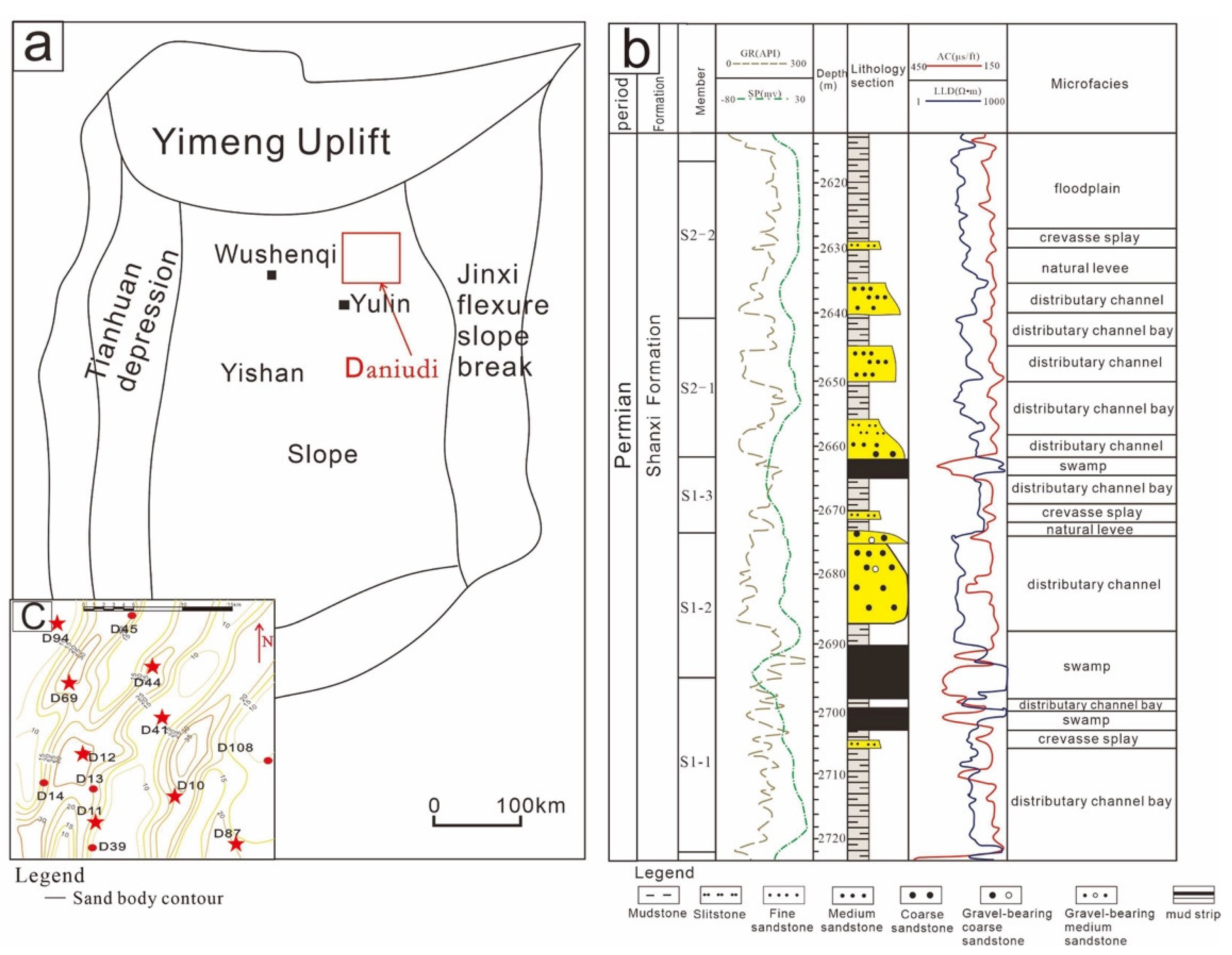

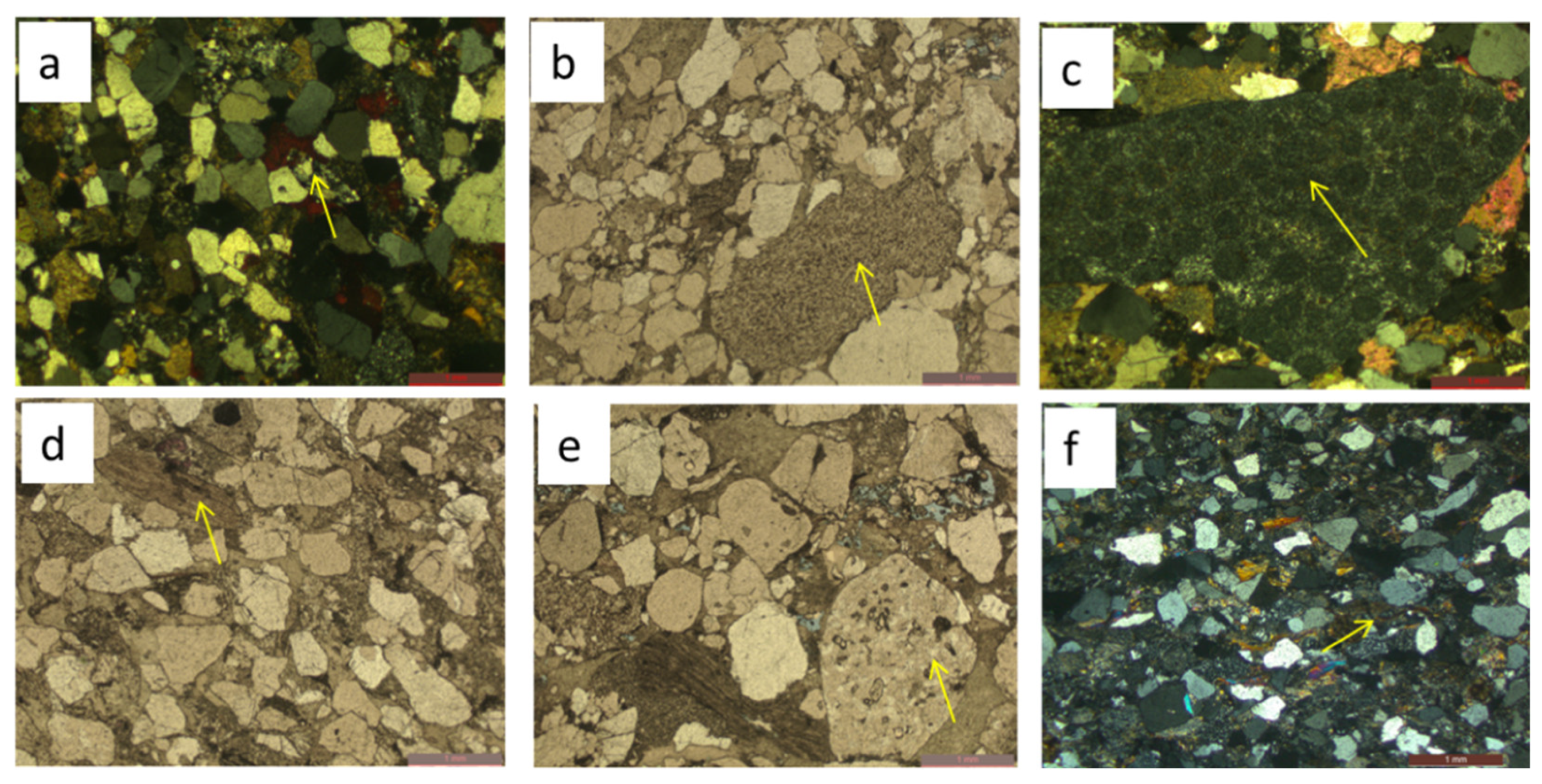

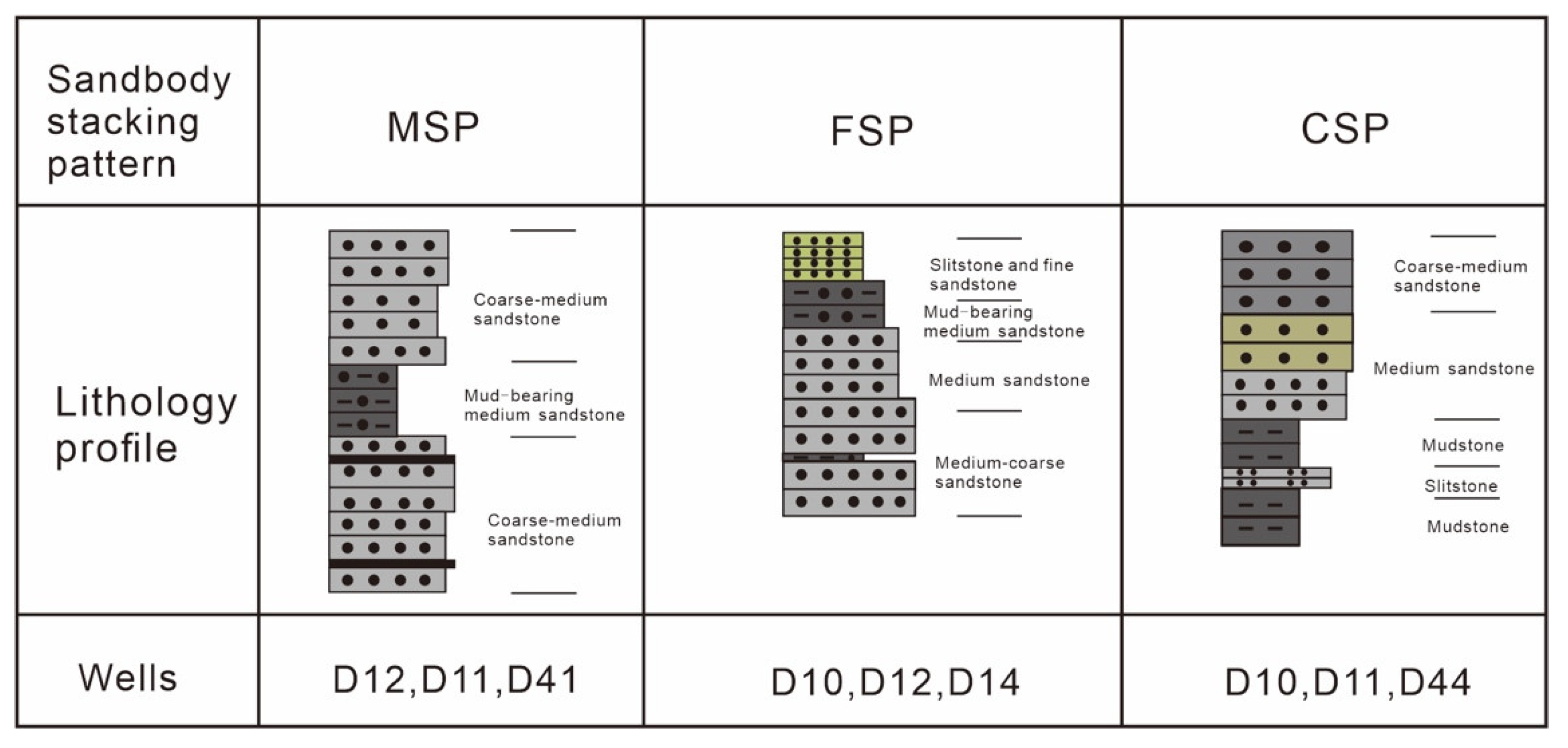

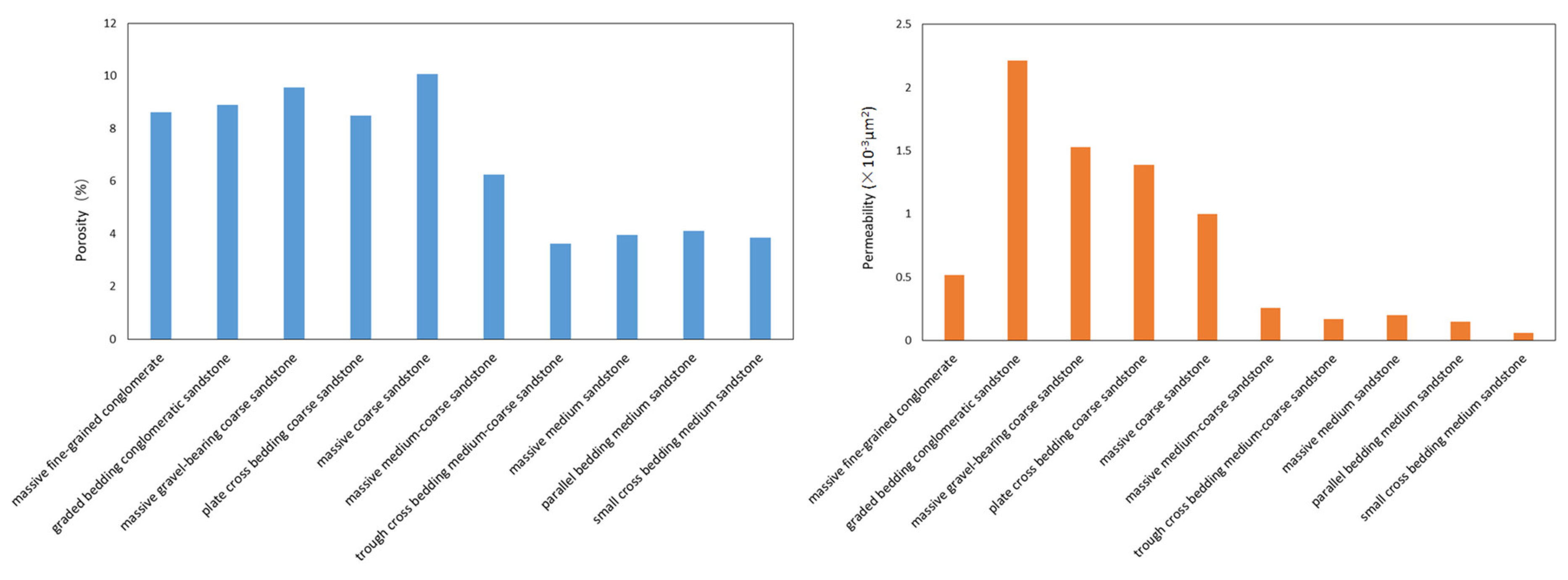
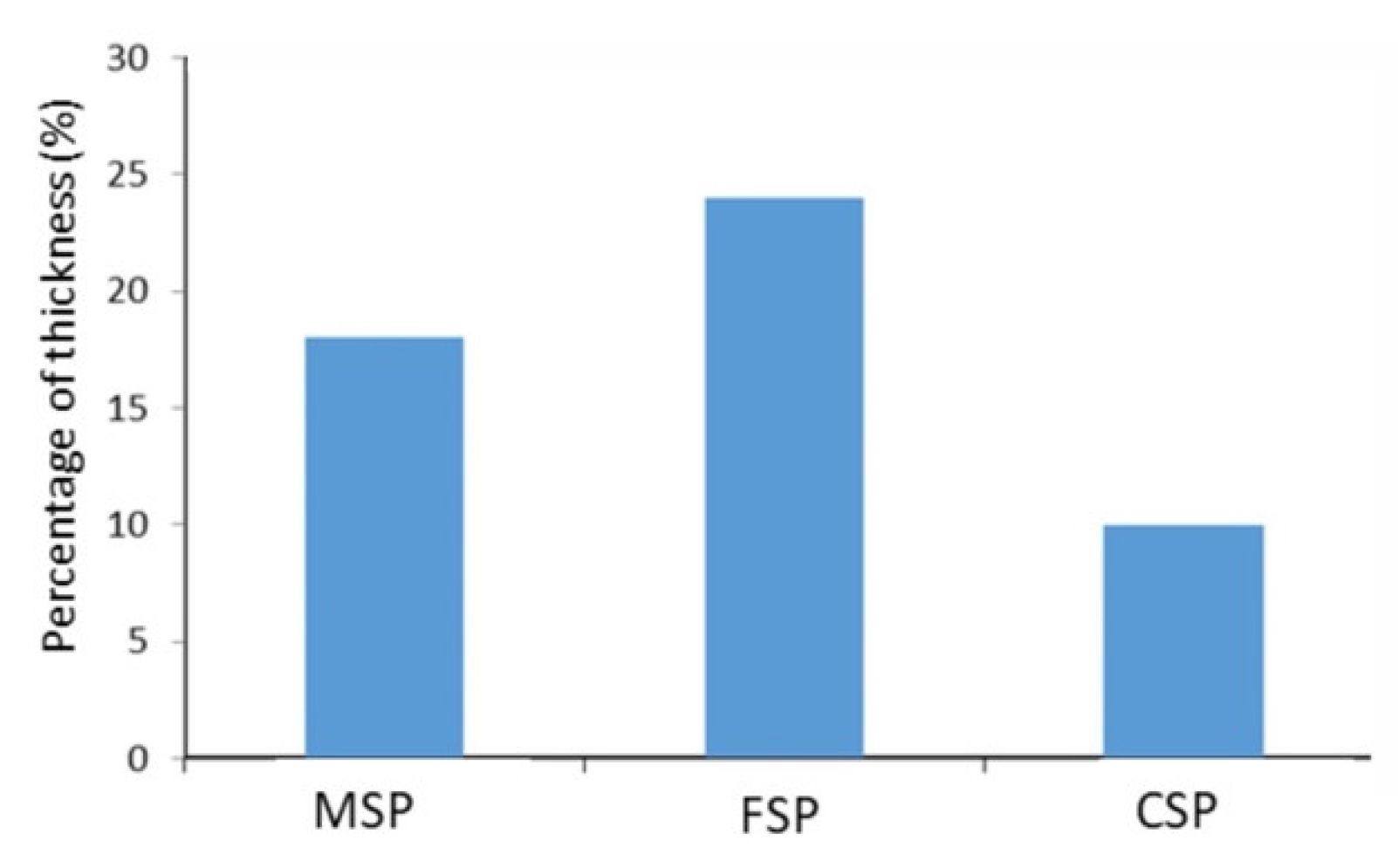



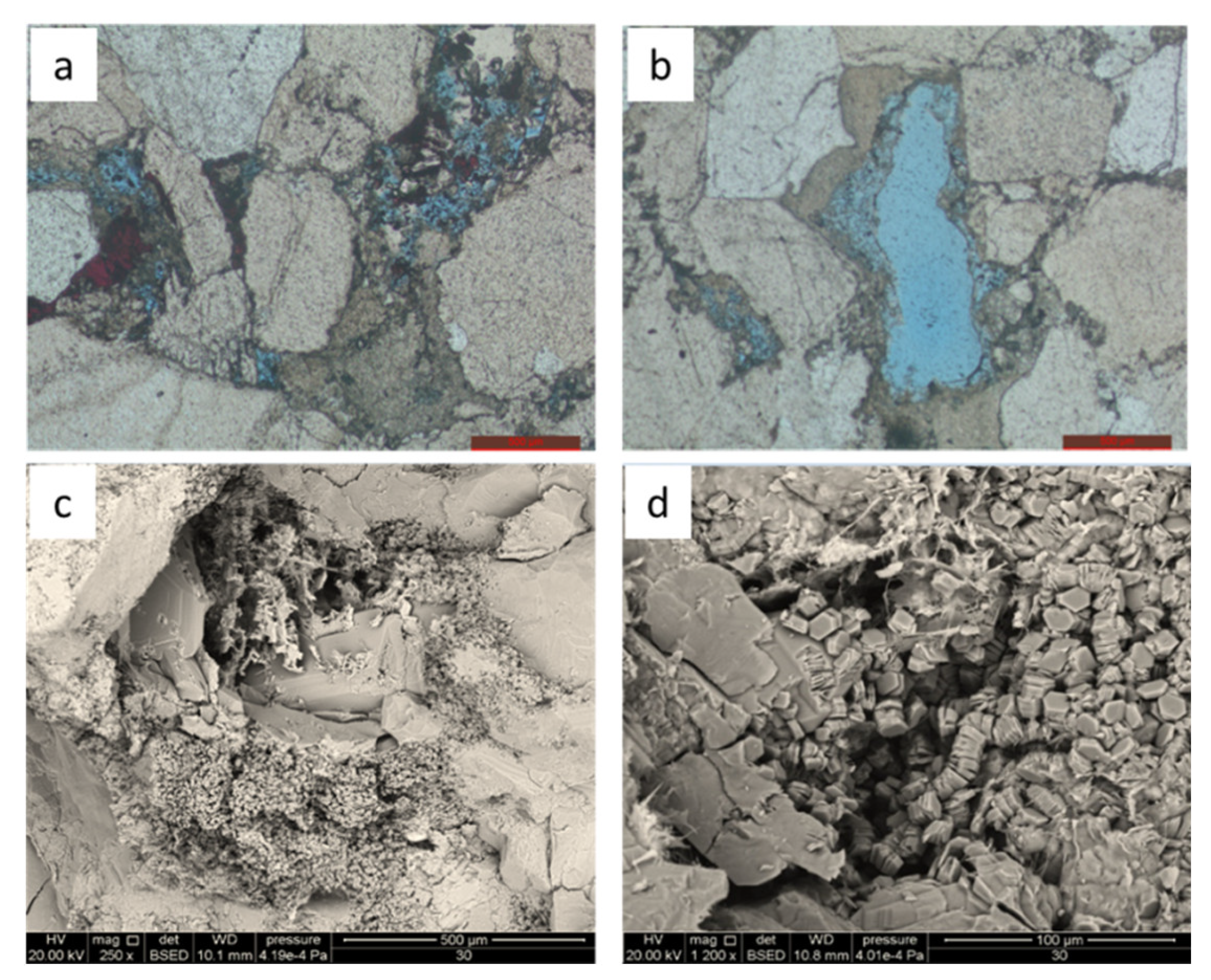
| Size Grading | Sedimentary Structures | Lithofacies |
|---|---|---|
| fine-grained conglomerate | massive | massive fine-grained conglomerate |
| conglomeratic sandstone | graded bedding | graded bedding conglomeratic sandstone |
| gravel-bearing coarse sandstone | massive | massive gravel-bearing coarse sandstone |
| coarse sandstone | plate cross-bedding | plate cross-bedding coarse sandstone |
| massive | massive coarse sandstone | |
| medium-coarse sandstone | massive | massive medium-coarse sandstone |
| trough cross-bedding | trough cross-bedding medium-coarse sandstone | |
| medium sandstone | massive | massive medium sandstone |
| parallel bedding | parallel bedding medium sandstone | |
| small cross-bedding | small cross-bedding medium sandstone |
| No. | Mineral Species and Content (%) | Total Clay Minerals (%) | ||||
|---|---|---|---|---|---|---|
| Quartz | Potassium Feldspar | Plagioclase | Calcite | Dolomite | ||
| 1 | 85.1 | 0 | 0 | 0 | 0 | 14.9 |
| 2 | 81.3 | 0 | 0 | 0 | 0.8 | 17.9 |
| 3 | 93.3 | 0 | 0 | 0 | 0 | 6.7 |
| 4 | 84 | 0 | 0 | 0 | 1.5 | 14.5 |
| 5 | 85.3 | 0 | 0 | 0 | 3.7 | 11 |
| 6 | 78.3 | 0 | 0 | 0 | 2.3 | 19.4 |
| 7 | 76.8 | 0 | 0 | 0 | 4.5 | 18.7 |
| 8 | 87 | 0 | 0 | 0 | 2.1 | 10.9 |
| 9 | 81.9 | 0 | 0 | 0 | 0 | 18.1 |
| 10 | 77.7 | 0 | 0 | 0 | 2.2 | 20.1 |
| 11 | 80.9 | 0 | 0 | 1.3 | 0 | 17.8 |
| 12 | 77.7 | 0 | 0 | 2.5 | 0 | 19.8 |
| 13 | 83.8 | 0 | 0 | 0 | 0 | 16.2 |
| 14 | 94.3 | 0 | 0 | 0 | 0 | 5.7 |
| 15 | 94.5 | 0 | 0 | 0 | 0 | 5.5 |
| 16 | 93.7 | 0 | 0 | 0 | 0 | 6.3 |
| 17 | 88.8 | 0 | 0 | 0 | 0 | 11.2 |
| 18 | 92.7 | 0 | 0 | 0 | 0 | 7.3 |
| 19 | 85.1 | 0 | 0 | 0 | 0 | 14.9 |
Publisher’s Note: MDPI stays neutral with regard to jurisdictional claims in published maps and institutional affiliations. |
© 2022 by the authors. Licensee MDPI, Basel, Switzerland. This article is an open access article distributed under the terms and conditions of the Creative Commons Attribution (CC BY) license (https://creativecommons.org/licenses/by/4.0/).
Share and Cite
He, Y.; Guo, H.; Lan, H.; Ling, C.; Fu, M. The Effect of Single Sandstone Stacking Pattern on the Sandstone Reservoir Physical Properties—A Case Study from the Shanxi Formation in the Daniudi Area, Northeastern Ordos Basin. Energies 2022, 15, 4740. https://doi.org/10.3390/en15134740
He Y, Guo H, Lan H, Ling C, Fu M. The Effect of Single Sandstone Stacking Pattern on the Sandstone Reservoir Physical Properties—A Case Study from the Shanxi Formation in the Daniudi Area, Northeastern Ordos Basin. Energies. 2022; 15(13):4740. https://doi.org/10.3390/en15134740
Chicago/Turabian StyleHe, Yun, Hengwei Guo, Haoxiang Lan, Can Ling, and Meiyan Fu. 2022. "The Effect of Single Sandstone Stacking Pattern on the Sandstone Reservoir Physical Properties—A Case Study from the Shanxi Formation in the Daniudi Area, Northeastern Ordos Basin" Energies 15, no. 13: 4740. https://doi.org/10.3390/en15134740
APA StyleHe, Y., Guo, H., Lan, H., Ling, C., & Fu, M. (2022). The Effect of Single Sandstone Stacking Pattern on the Sandstone Reservoir Physical Properties—A Case Study from the Shanxi Formation in the Daniudi Area, Northeastern Ordos Basin. Energies, 15(13), 4740. https://doi.org/10.3390/en15134740






